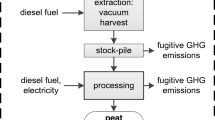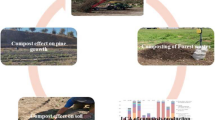Abstract
The amount of waste which is being recycled is increasing in Europe. Garden waste is increasingly composted and land applied. However, composting to full maturity requires resources in terms of space, equipment and labour. Alternatives could include a simple shredding, or composting for a shorter time. Finally, an option could be to remove trunks and large branches which are not easy to compost and incinerate them to recover energy. In order to assess these options and the associated environmental impacts, it is necessary to have good estimates of emissions and other inventory factors during the different steps of the life cycle of the compost products. Especially, the impacts occurring after land application are difficult to estimate. The objective of the current paper is to estimate environmental inventory factors for land application of four garden waste products: shredded garden waste, shredded garden waste after removal of the woody fraction, immature garden waste compost and mature garden waste compost. Soil incubations of the materials were conducted in order to assess the carbon (C) and nitrogen (N) dynamics occurring after incorporation in soil. Subsequently, the results were used to calibrate the mineralisation kinetics of the materials in the agroecosystem model Daisy. Subsequently, the model was used to simulate C and N dynamics under different environmental conditions and emissions to the environment and used to derive inventory factors. Nine soil and climate combinations were included in the simulation study to cover local conditions commonly found in Northern Europe. The degradability of the garden waste products increased when the woody fraction of garden waste was removed and generally the degradability of the product was decreased by composting. All four products showed initial immobilisation of N in soil, but it was clear that removal of the woody fraction and composting reduced the length and severity of the immobilisation phase. The approach taken in the current paper using soil incubations to estimate decomposition parameters for the materials and subsequently an agroecosystem model to extrapolate the observations proved efficient at estimating inventory factors under various environmental conditions and fertilisation levels. Under low N availability conditions, the harvest factor, which estimates the fraction of N harvested in response to application of an amount of compost ranged between 0.10 and 0.18 for a sandy loam soil and medium precipitation conditions for Northern European while it ranged from negative values to 0.12 under conditions of ample N supply. These results were also clearly reflected in the emission factors for N leaching to the groundwater and losses to surface water, which were higher under high N availability than under low. The harvest factor, emission factors for ammonia, N leaching to ground water and loss to surface water proved to be very dependent on the local conditions like the soil type, precipitation regime and general fertilisation level, whereas the biochemical composition of the materials was of less importance for these factors. In contrast, the C sequestration factor was almost unaffected by the environmental conditions but depended to a large extent on the degradability of the added material.






Similar content being viewed by others
References
EuroStat (2016). Municipal waste generation and treatment, by type of treatment method (tsdpc240), http://ec.europa.eu/eurostat/cache/metadata/DE/tsdpc240_esmsip.htm.
Carlsbaek, M., (2015). Use of compost in horticulture and landscaping. In: Christensen, T.H. (ed.), Solid Waste Technology & Management. Wiley Publishers, pp. 651–664.
Martínez-Blanco, J., Lazcano, C., Christensen, T. H., Muñoz, P., Rieradevall, J., Møller, J., Antón, A., & Boldrin, A. (2013). Compost benefits for agriculture evaluated by life cycle assessment. A review. Agronomy for Sustainable Development, 33, 721–732.
Feller, C., & Bernoux, M. (2008). Historical advances in the study of global terrestrial soil organic carbon sequestration. Waste Management, 28, 734–740.
Komilis, D. P. (2006). A kinetic analysis of solid waste composting at optimal conditions. Waste Management, 26, 82–91.
Amlinger, F., Gotz, B., Dreher, P., Geszti, J., & Weissteiner, C. (2003). Nitrogen in biowaste and yard waste compost: dynamics of mobilisation and availability—a review. European Journal of Soil Biology, 39, 107–116.
Bary, A. I., Cogger, C. G., Sullivan, D. M., & Myhre, E. A. (2005). Characterization of fresh yard trimmings for agricultural use. Bioresource Technology, 96, 1499–1504.
Hansen, S., Abrahamsen, P., Petersen, C. T., & Styczen, M. (2012). Daisy: model use, calibration, and validation. Transactions of the ASABE, 55, 1315–1333.
de Willigen, P. (1991). Nitrogen turnover in the soil-crop system; comparison of fourteen simulation models. Fertilizer Research, 27, 141–149.
Bruun, S., Christensen, B. T., Hansen, E. M., Magid, J., & Jensen, L. S. (2003). Calibration and validation of the soil organic matter dynamics of the Daisy model with data from the Askov long-term experiments. Soil Biology and Biochemistry, 35, 67–76.
Bruun, S., Hansen, T. L., Christensen, T. H., Magid, J., & Jensen, L. S. (2006). Application of processed organic municipal solid waste on agricultural land—a scenario analysis. Environmental Modeling & Assessment, 11, 251–265.
Bruun, S., Yoshida, H., Nielsen, M. P., Jensen, L. S., Christensen, T. H., & Scheutz, C. (2016). Estimation of long-term environmental inventory factors associated with land application of sewage sludge. Journal of Cleaner Production, 126, 440–450.
Yoshida, H., Nielsen, M. P., Scheutz, C., Jensen, L. S., Bruun, S., & Christensen, T. H. (2016). Long-term emission factors for land application of treated organic municipal waste. Environmental Modeling & Assessment, 21, 111–124.
Styczen, M., Hansen, S., Jensen, L.S., Svendsen, H., Abrahamsen, P., Børgesen, C.D., Thirup, C., Østergaard, H.S., (2004). Standard setup of the Daisy model. Guideline and background. DHI Institut for Vand og Miljø.
Bruun, S., & Jensen, L. S. (2002). Initialisation of the soil organic matter pools of the daisy model. Ecological Modelling, 153, 291–295.
Statbank Denmark, 2012. Cultivated area (AFG07). http://www.statbank.dk/afg07.
Naturerhvervsstyrelsen, 2013. Vejledning om gødsknings-og harmoniregler 2012/13. http://1.naturerhverv.fvm.dk/goedningsregnskab.aspx?ID=2268.
Vinther, F. P., & Hansen, S. (2004). SimDen—a simpel model to quantification of N2O-emission and denitrification (in Danish). DJF rapport Markbrug, 104, 3–48.
Myers, R. J. K., van Noordwijk, M., & Vityakon, P. (1997). Synchrony of nutrient release and plant demand: Plant litter quality, soil environment and farmer management options. In G. Cadisch & K. E. Giller (Eds.), Driven by nature. Plant litter quality and decomposition (pp. 3–30). Wallingford: CAB International.
Sullivan, D. M., Nartea, T. J., Bary, A. I., Cogger, C. G., & Myhre, E. A. (2004). Nitrogen availability and decomposition of urban yard trimmings in soil. Soil Science, 169, 697–707.
Gilmour, J. (1998). Carbon and nitrogen mineralization during co-utilization of biosolids and composts. In S. Brown, J. S. Angle, & L. Jacobs (Eds.), Beneficial co-utilization of agricultural, municipal and industrial by-products (pp. 89–112). Netherlands: Springer.
Luxhøi, J., Bruun, S., Stenberg, B., Breland, T. A., & Jensen, L. S. (2006). Prediction of gross and net N mineralization-immobilization-turnover from respiration. Soil Science Society of America Journal, 70, 1121–1128.
Jaber, F. H., Shukla, S., Stoffella, P. J., Obreza, T. A., & Hanlon, E. A. (2005). Impact of organic amendments on groundwater nitrogen concentrations for sandy and calcareous soils. Compost science & utilization, 13, 194–202.
Baldi, E., Toselli, M., Marcolini, G., Quartieri, M., Cirillo, E., Innocenti, A., & Marangoni, B. (2010). Compost can successfully replace mineral fertilizers in the nutrient management of commercial peach orchard. Soil Use and Management, 26, 346–353.
Sommer, S. G., Jensen, L. S., Clausen, S. B., & Søgaard, H. T. (2006). Ammonia volatilization from surface-applied livestock slurry as affected by slurry composition and slurry infiltration depth. Journal of Agricultural Science, 144, 229–235.
Bary, A. I., Cogger, C. G., & Myhre, E. A. (2004). Yard trimmings as a source of nitrogen for crop production. Compost science & utilization, 12, 11–17.
Mamo, M., Rosen, C. J., & Halbach, T. R. (1999). Nitrogen availability and leaching front soil amended with municipal solid waste compost. Journal of Environmental Quality, 28, 1074–1082.
Erhart, E., Feichtinger, F., & Hartl, W. (2007). Nitrogen leaching losses under crops fertilized with biowaste compost compared with mineral fertilization. Journal of Plant Nutrition and Soil Science, 170, 608–614.
Gerke, H. H., Arning, M., & Stöppler-Zimmer, H. (1999). Modeling long-term compost application effects on nitrate leaching. Plant and Soil, 213, 75–92.
Andersen, J. K., Boldrin, A., Samuelsson, J., Christensen, T. H., & Scheutz, C. (2010). Quantification of greenhouse gas emissions from windrow composting of garden waste. Journal of Environmental Quality, 39, 713–724.
Funding
We acknowledge 3R Research School at the Technical University of Denmark, Vestforbrændingen, AffaldVarme Århus and University of Copenhagen for funding the study.
Author information
Authors and Affiliations
Corresponding author
Electronic Supplementary Material
ESM 1
(DOCX 34 kb)
Rights and permissions
About this article
Cite this article
Nielsen, M.P., Yoshida, H., Raji, S.G. et al. Deriving Environmental Life Cycle Inventory Factors for Land Application of Garden Waste Products Under Northern European Conditions. Environ Model Assess 24, 21–35 (2019). https://doi.org/10.1007/s10666-018-9591-9
Received:
Accepted:
Published:
Issue Date:
DOI: https://doi.org/10.1007/s10666-018-9591-9




